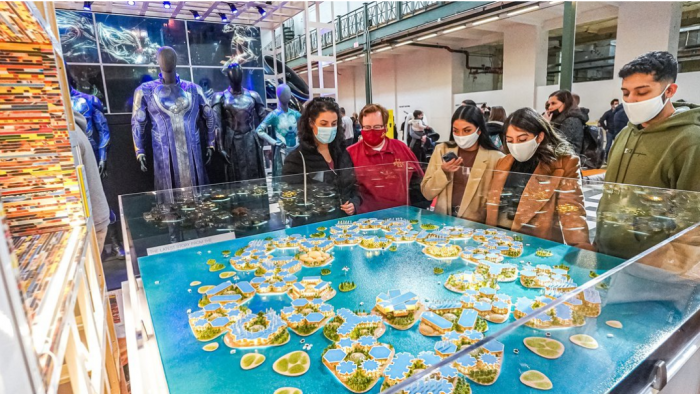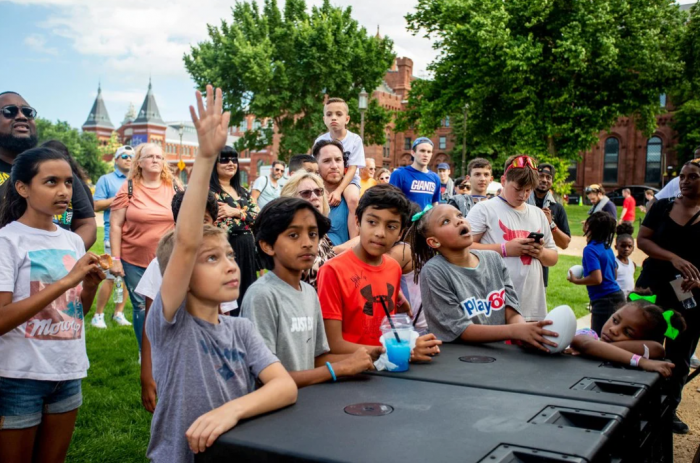What It Will Take to Inspire Hope for a Better Tomorrow
Visitor data from the Smithsonian’s FUTURES exhibition provides a road map for how to navigate the world ahead.

We all want to be hopeful about the future. But sometimes it seems the world is conspiring against us. Bad news and worrying trends stream across our screens and news feeds. Public discourse on the future is often dominated by dystopian narratives and commercial agendas. No wonder that, in global surveys, people report being angrier, sadder and more fearful than ever before. Still, we yearn for reasons to be optimistic.
FUTURES,the Smithsonian’s first major building-wide exploration of what lies ahead, sought to address this gap. For eight months between November and July 2022, more than 650,000 people immersed themselves in the exhibition’s 32,000-square feet packed with groundbreaking ideas, contemporary art commissions, prototypes, immersive experiences and historic objects—all, explicitly, focusing on hopeful solutions to navigate the world to come.
The show’s curatorial team set out to create an exhibition that helped people imagine the future they wanted, not the future they feared. Our premise was that hope was the best way to inspire action. As Carl Sagan says: “The visions we offer our children shape the future. It matters what those visions are. Often they become self-fulfilling prophecies. Dreams are maps.”

Throughout the exhibition, we took every opportunity to ask visitors about their own dreams for the future. In partnership with leading futurists and researchers like the Institute for the Future, we built an experience that listened as much as it spoke, using multiple input methods, from traditional surveys and focus groups to high-tech interactives like Suchi Reddy’s AI-driven sculpture me + youor the FUTURES Beacons digital kiosks created by the LAB at Rockwell Group.
At each juncture, we engaged visitors with questions specially designed to get them to think more flexibly and creatively about the world they wanted to live in.
Visitors shared nearly one million insights—from what might unite our divided world to whether they could be best friends with a robot.
The result? Possibly one of the most comprehensive glimpses into how people have been thinking and feeling about the future during the seismic shifts of the past few years—and one of the largest data collections of its kind. The show’s visitors shared nearly one million insights into their visions of the future—from what event might unite our divided world most effectively to whether they could be best friends with a robot. They told us what they felt most hopeful about, where they felt the most power to affect change, and where they felt neither. And almost all, an astonishing 97 percent, reported a shift after visiting in mindset or emotion about the future.

Taken together, this data offers a potential roadmap for anyone seeking to be inspired as well as a way to inspire hope and action. Because instead of asking why we should be hopeful, we should be asking, quite literally, how? How can we shift our mindsets to see the possibilities, not just the calamities? How can we energize ourselves and others to make an impact?
The answers are both affirming and surprising, and reveal three key strategies (see below) we can all use to feel more hopeful about the future.
Hope Drives Action

First, and perhaps most powerful: Hope drives action. We know that awareness of a problem in and of itself doesn’t often lead to change. When faced with huge challenges like climate change and social division, it’s easy to feel overwhelmed and powerless. And yet today common wisdom seems to be that that you have to scare people into taking action on a particular issue or problem. You need to focus on what could go wrong, the disastrous implications and dire consequences that might happen if we are not sufficiently vigilant or motivated.
FUTURES’ optimistic approach was an audacious experiment in taking the opposite approach. What would happen if we focused instead on what could go right?
A lot would happen, it turns out. An incredible 77 percent of people reported feeling more hopeful about the future after seeing FUTURES. A similarly overwhelming majority of 80 percent reported being inspired to take action, as well as feeling a sense of increased responsibility for shaping the future. The data showed that visitors saw huge challenges, like climate change, as seemingly less daunting.
In one particularly significant example, we asked audiences in a pre-exhibition study about their biggest concerns. While climate change topped the list, most people had little hope it could be resolved, and felt they had no power to make a difference.
But after seeing FUTURES and being exposed to some of the concepts and ideas in the show, like Oceanix’ sustainable floating city, fashion made from recycled fish skin, and the X project to feed billions of people, visitors reported climate was still a pressing issue, but they overwhelmingly wanted to take action. Even better, they had concrete, measurable ideas about what actions to take.
The results were clear. Visitors gained a greater sense of hope and agency around climate change, and taking personal action no longer felt futile.
The Power of Mental Time Travel

Specificity training, or “mental time travel” helps create hope for the future. The concept of specificity training was foundational to FUTURES, based on investigations done by the Institute for the Future, a leading research and educational organization devoted to future studies. The premise is simple but transformative: the more concretely you can envision the details of a possible future, the more hopeful you feel about its possibility and the more capable you feel to take actions to make that future, or others, a reality.
Often our ideas about the future are fuzzy or vague. Recent research shows we can picture six months out, or a couple years, but beyond 15 years in the future, we struggle. Everything in FUTURES explicitly encouraged the visitor to imagine how each prototype or invention might apply to the “real world” and invite inquiry to what it could mean for generations to come.
As a result, 83 percent of people reported being able to imagine a better possible world after visiting FUTURES. Visitors told us the “mental time travel” in FUTURES was what gave them hope: the ability to understand the progress already made to date on solving big challenges, such as seeing in person Virgin Hyperloop’s history-making, high-speed Pegasus pod; the chance to see actual solutions being tackled by real people. Concrete exercises that allowed visitors to play out impacts over time, like the display of a futuristic commute in the full-scale Bell Nexus autonomous air taxi, and the ability to design and run their own future cities at the AI Co-Lab, made change seem more realistic and made the future feel closer.
Closing the Hopefulness Gap

We have a “hopefulness gap”—but shifting this could be a key to shaping the future we most want. We have more faith in innovation and technology than we do in human cooperation.
Early research for the exhibition showed that the types of futures people most wanted to see were peaceful and equitable. Unfortunately, they also thought these were the least likely to ever happen. This difference created a sense of despair and hopelessness.
What we found during FUTURES was consistent with this—people thought futures that were creative and exciting were much more likely to occur, largely because they had faith that technology, leaps of innovation, or transformative discoveries by individual geniuses would create these futures.
Visitors were much less optimistic about outcomes like peacefulness and empathy, ones that relied on people to band together to solve problems communally. Much of FUTURES focused on the former, stories of other people inventing technological solutions to our problems. This is a common trend in stories about the future.
But by focusing on the latter—by telling and celebrating examples of broad and effective human collaboration, from communities large and small—we may have uncovered the most promising way forward to create wide-scale hope for the future.
New Generations Will Bring About Change

When we started our journey with FUTURES over four years ago, we decided that instead of helping people imagine what could go wrong, we wanted to help them imagine what could go right. And our hypothesis was that by doing that, we could inspire them with a sense of agency and action.
It has been especially gratifying to see the impact of the exhibition on younger people. Far from being disengaged or disconnected, younger generations are eager for impact. Nearly three quarters of visitors to FUTURES were 40 years old or younger, much younger than traditional museum audiences.
Across the board, the youngest groups reported getting the most out of the exhibition. They were more likely to talk to friends and family about the future after seeing the exhibition, to see solutions for the future that were exciting to them, and to recognize similarities between themselves and the people shaping the future. And that should make us all hopeful.
Oh, and in case you were wondering, when asked what might unite different people most effectively in the future, the top two answers were a universal language and an alien invasion.
So we still have at least one thing to be worried about.
Three Strategies For Building Hope
Seek out real-world or potential solutions to the issues in the future that worry you the most. Immerse yourself in learning about projects or research that is seeking to address these concerns. Discuss them with friends and family. There is a lot of information out there about both problems and possible solutions, make sure you’re spending at least as much time with the latter as the former. You might just feel more motivated to do something to make them come true.
When you find something that excites you about the future—an idea, an invention, a social movement—take a few minutes to imagine how that might play out over the next 30 years. What might it become, what would it look or feel like in practice, how might it change peoples’ lives? The more of your imagination you can bring to the future, the more you’ll be able to visualize pathways to achieving it.
Look for, or create yourself, examples of people coming together to solve problems. They are all around us, though we often fail to identify them as “futuristic” in the way we do a new gadget or scientific discovery. Apply future thinking to community solutions and you may find yourself feeling more hopeful about tomorrow.

This article was originally published by Smithsonian magazine. Copyright 2022 Smithsonian Institution. Reprinted with permission from Smithsonian Enterprises. All rights reserved. Reproduction in any medium is strictly prohibited without permission from Smithsonian Institution.
Rachel Goslins served as the director of the Smithsonian’s historic Arts + Industries Building from 2016 to 2022.
Posted: 19 September 2022
-
Categories:
Art and Design , Collaboration , Education, Access & Outreach , Feature Stories , History and Culture , Science and Nature







